Mental Health Nurse Perspectives on Suicidal Patients: A Dissertation
VerifiedAdded on 2022/09/05
|45
|9441
|17
Thesis and Dissertation
AI Summary
This dissertation delves into the perspectives of mental health nurses regarding the care of suicidal patients within adult acute mental health settings. The study begins with a comprehensive background, highlighting the prevalence of suicide and the crucial role of nurses as frontline healthcare providers. It establishes the research question using the PEO framework, focusing on the nurses' perceptions and nursing care provided to suicidal patients. The methodology involves a systematic search strategy using CINAHL and MEDLINE databases, along with manual searches, to identify relevant articles published from 2017 onwards. The study employs specific inclusion and exclusion criteria to narrow down the selection, culminating in the critical appraisal of ten selected articles using the Caldwell framework. The analysis reveals that the majority of the articles are qualitative, exploring nurses' experiences, attitudes, and challenges in dealing with suicidal patients. The findings cover themes such as nurses' alertness to suicidal cues, self-blame and emotional turmoil, and strategies for managing patient anxiety. The dissertation further outlines a dissemination plan and discusses potential barriers to implementing the findings. The research underscores the importance of understanding and addressing nurses' perspectives to improve the care of suicidal patients and ultimately reduce in-patient suicide rates.
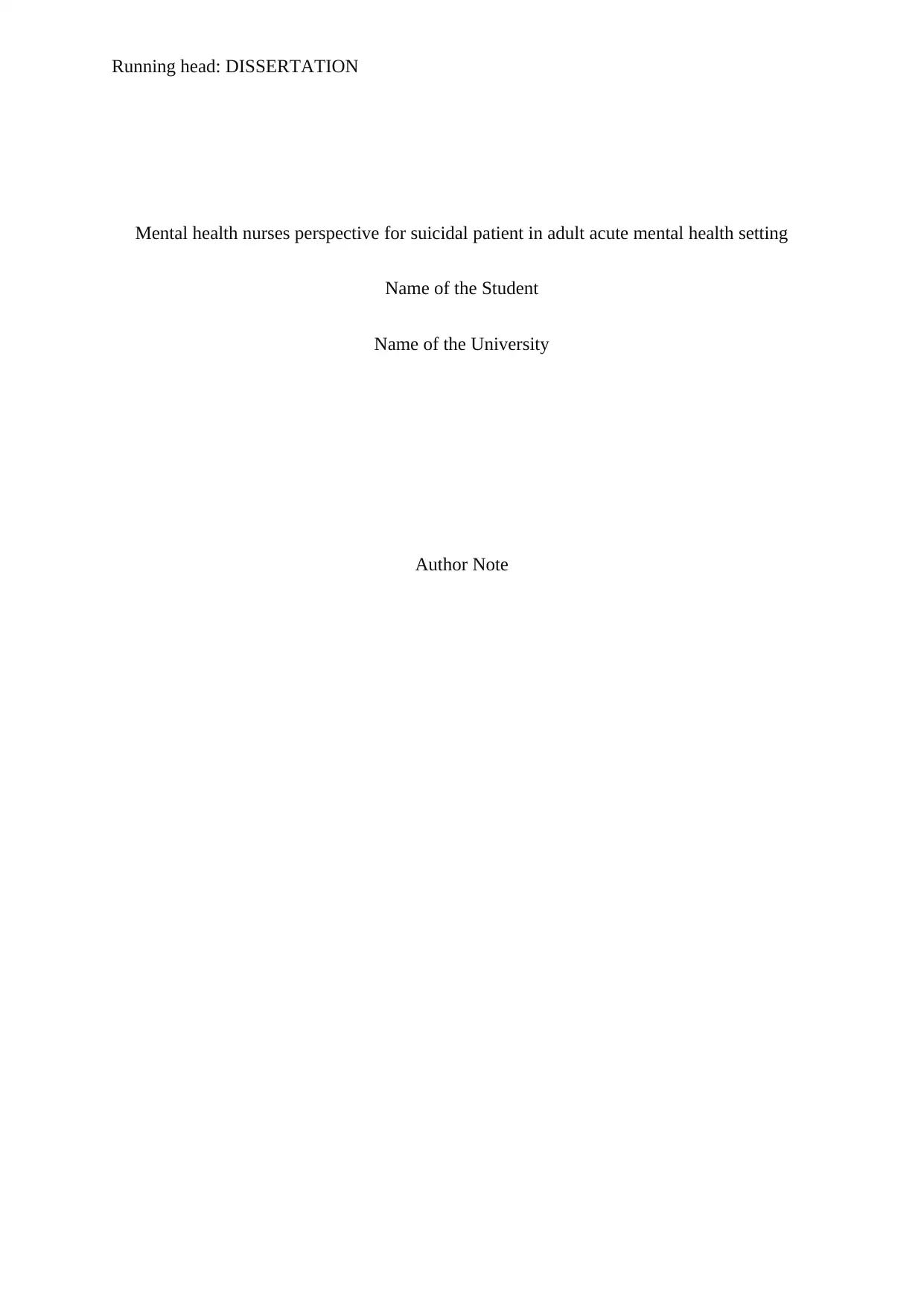
Running head: DISSERTATION
Mental health nurses perspective for suicidal patient in adult acute mental health setting
Name of the Student
Name of the University
Author Note
Mental health nurses perspective for suicidal patient in adult acute mental health setting
Name of the Student
Name of the University
Author Note
Paraphrase This Document
Need a fresh take? Get an instant paraphrase of this document with our AI Paraphraser
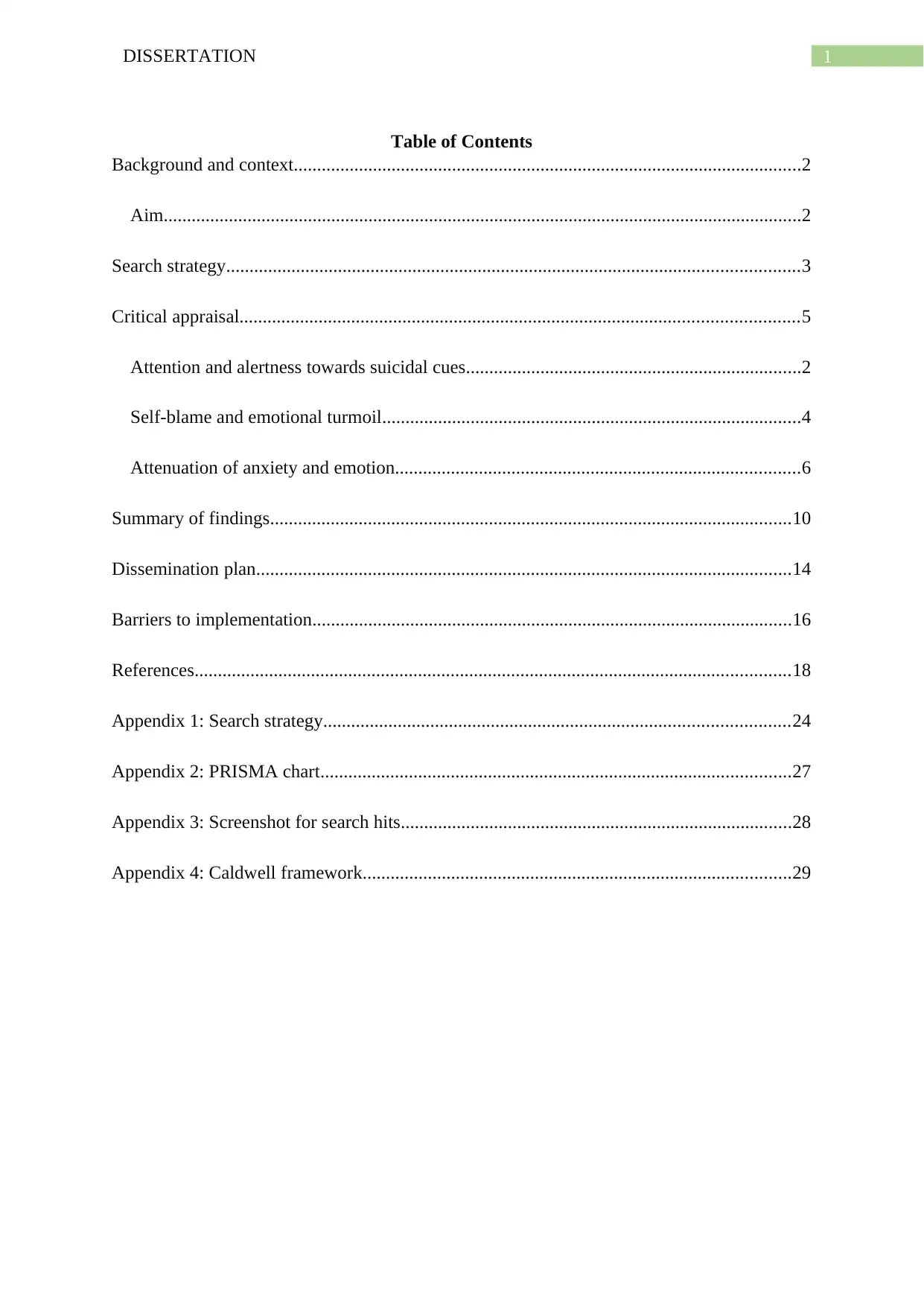
1DISSERTATION
Table of Contents
Background and context.............................................................................................................2
Aim.........................................................................................................................................2
Search strategy...........................................................................................................................3
Critical appraisal........................................................................................................................5
Attention and alertness towards suicidal cues........................................................................2
Self-blame and emotional turmoil..........................................................................................4
Attenuation of anxiety and emotion.......................................................................................6
Summary of findings................................................................................................................10
Dissemination plan...................................................................................................................14
Barriers to implementation.......................................................................................................16
References................................................................................................................................18
Appendix 1: Search strategy....................................................................................................24
Appendix 2: PRISMA chart.....................................................................................................27
Appendix 3: Screenshot for search hits....................................................................................28
Appendix 4: Caldwell framework............................................................................................29
Table of Contents
Background and context.............................................................................................................2
Aim.........................................................................................................................................2
Search strategy...........................................................................................................................3
Critical appraisal........................................................................................................................5
Attention and alertness towards suicidal cues........................................................................2
Self-blame and emotional turmoil..........................................................................................4
Attenuation of anxiety and emotion.......................................................................................6
Summary of findings................................................................................................................10
Dissemination plan...................................................................................................................14
Barriers to implementation.......................................................................................................16
References................................................................................................................................18
Appendix 1: Search strategy....................................................................................................24
Appendix 2: PRISMA chart.....................................................................................................27
Appendix 3: Screenshot for search hits....................................................................................28
Appendix 4: Caldwell framework............................................................................................29
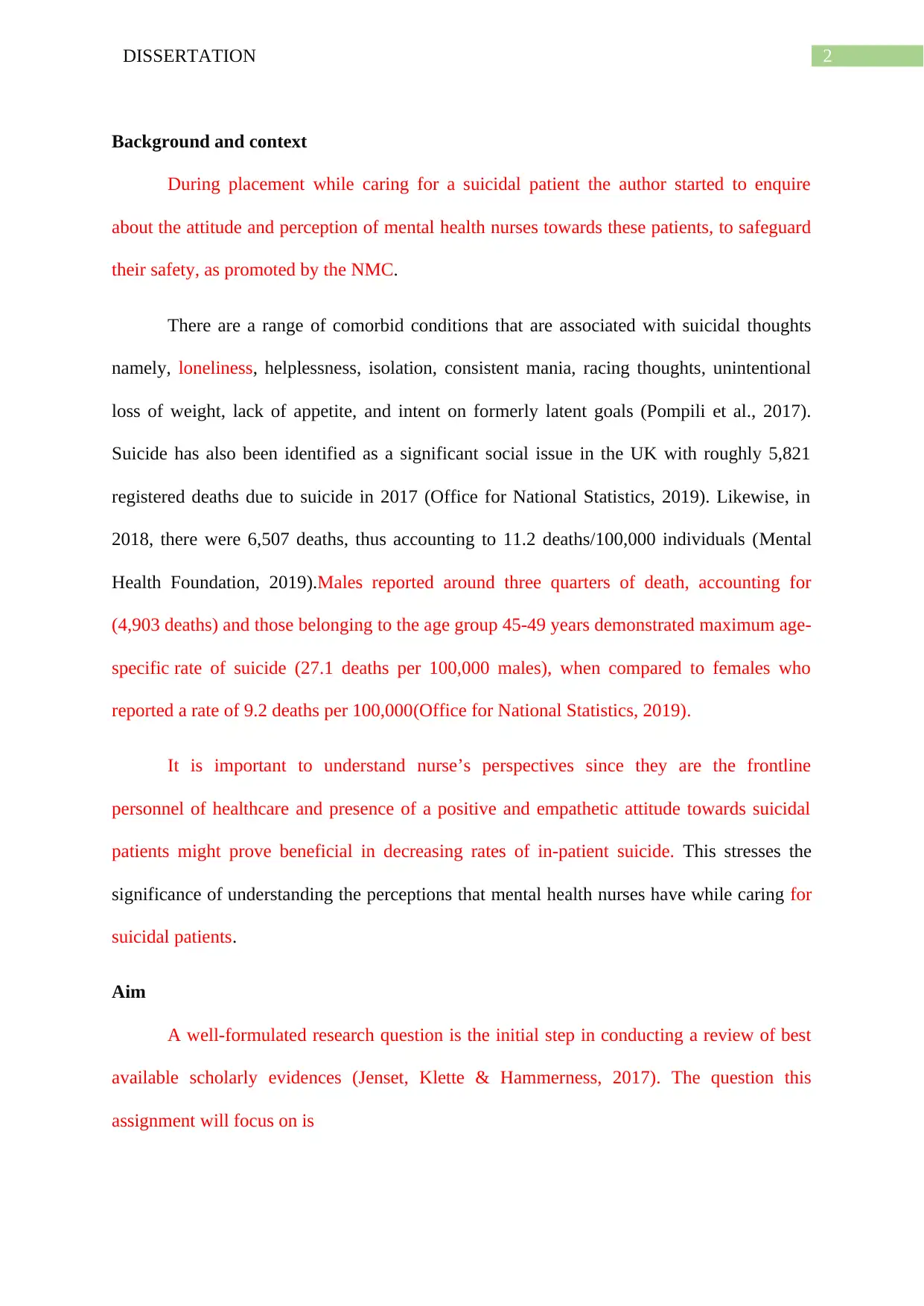
2DISSERTATION
Background and context
During placement while caring for a suicidal patient the author started to enquire
about the attitude and perception of mental health nurses towards these patients, to safeguard
their safety, as promoted by the NMC.
There are a range of comorbid conditions that are associated with suicidal thoughts
namely, loneliness, helplessness, isolation, consistent mania, racing thoughts, unintentional
loss of weight, lack of appetite, and intent on formerly latent goals (Pompili et al., 2017).
Suicide has also been identified as a significant social issue in the UK with roughly 5,821
registered deaths due to suicide in 2017 (Office for National Statistics, 2019). Likewise, in
2018, there were 6,507 deaths, thus accounting to 11.2 deaths/100,000 individuals (Mental
Health Foundation, 2019).Males reported around three quarters of death, accounting for
(4,903 deaths) and those belonging to the age group 45-49 years demonstrated maximum age-
specific rate of suicide (27.1 deaths per 100,000 males), when compared to females who
reported a rate of 9.2 deaths per 100,000(Office for National Statistics, 2019).
It is important to understand nurse’s perspectives since they are the frontline
personnel of healthcare and presence of a positive and empathetic attitude towards suicidal
patients might prove beneficial in decreasing rates of in-patient suicide. This stresses the
significance of understanding the perceptions that mental health nurses have while caring for
suicidal patients.
Aim
A well-formulated research question is the initial step in conducting a review of best
available scholarly evidences (Jenset, Klette & Hammerness, 2017). The question this
assignment will focus on is
Background and context
During placement while caring for a suicidal patient the author started to enquire
about the attitude and perception of mental health nurses towards these patients, to safeguard
their safety, as promoted by the NMC.
There are a range of comorbid conditions that are associated with suicidal thoughts
namely, loneliness, helplessness, isolation, consistent mania, racing thoughts, unintentional
loss of weight, lack of appetite, and intent on formerly latent goals (Pompili et al., 2017).
Suicide has also been identified as a significant social issue in the UK with roughly 5,821
registered deaths due to suicide in 2017 (Office for National Statistics, 2019). Likewise, in
2018, there were 6,507 deaths, thus accounting to 11.2 deaths/100,000 individuals (Mental
Health Foundation, 2019).Males reported around three quarters of death, accounting for
(4,903 deaths) and those belonging to the age group 45-49 years demonstrated maximum age-
specific rate of suicide (27.1 deaths per 100,000 males), when compared to females who
reported a rate of 9.2 deaths per 100,000(Office for National Statistics, 2019).
It is important to understand nurse’s perspectives since they are the frontline
personnel of healthcare and presence of a positive and empathetic attitude towards suicidal
patients might prove beneficial in decreasing rates of in-patient suicide. This stresses the
significance of understanding the perceptions that mental health nurses have while caring for
suicidal patients.
Aim
A well-formulated research question is the initial step in conducting a review of best
available scholarly evidences (Jenset, Klette & Hammerness, 2017). The question this
assignment will focus on is
⊘ This is a preview!⊘
Do you want full access?
Subscribe today to unlock all pages.

Trusted by 1+ million students worldwide
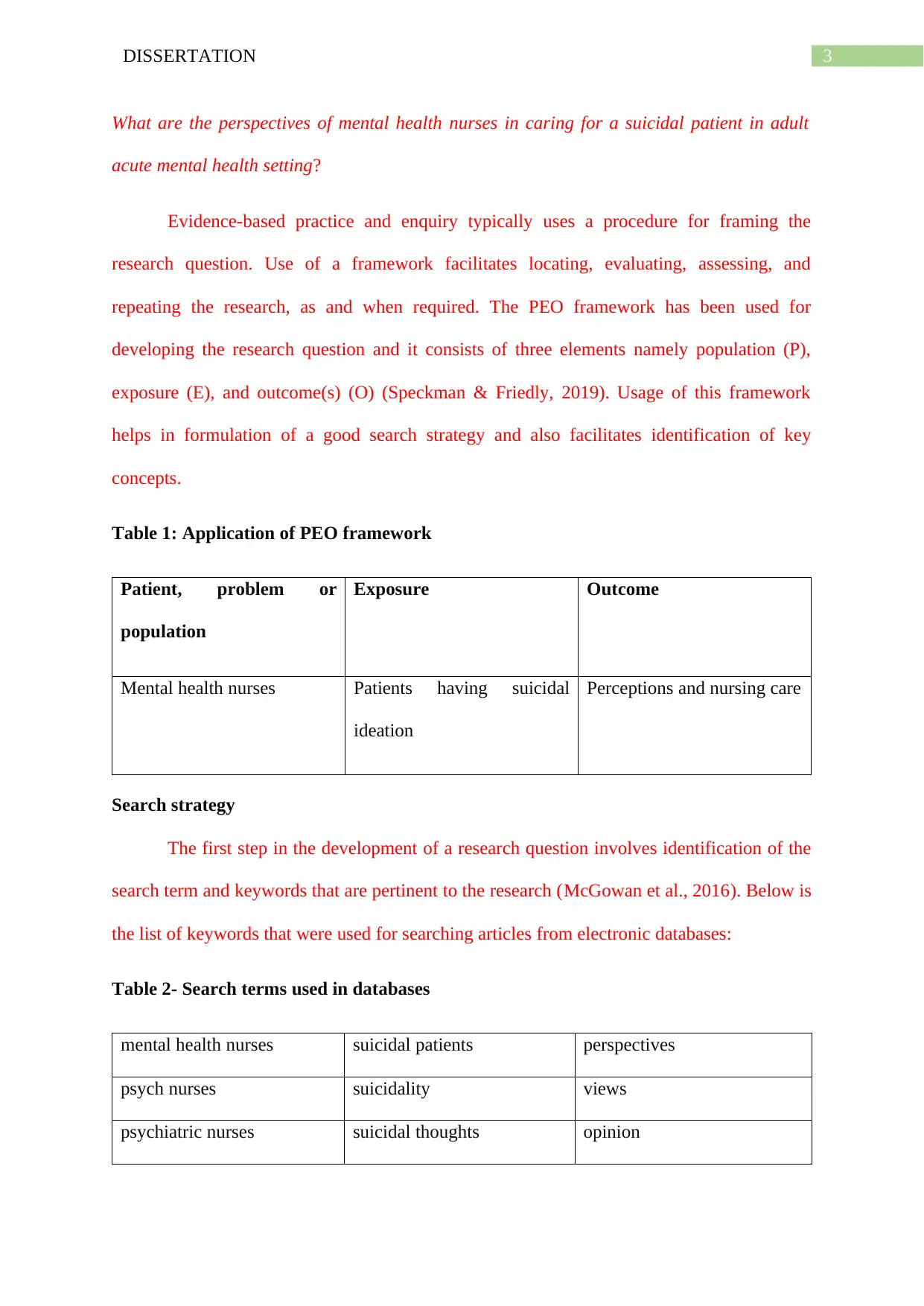
3DISSERTATION
What are the perspectives of mental health nurses in caring for a suicidal patient in adult
acute mental health setting?
Evidence-based practice and enquiry typically uses a procedure for framing the
research question. Use of a framework facilitates locating, evaluating, assessing, and
repeating the research, as and when required. The PEO framework has been used for
developing the research question and it consists of three elements namely population (P),
exposure (E), and outcome(s) (O) (Speckman & Friedly, 2019). Usage of this framework
helps in formulation of a good search strategy and also facilitates identification of key
concepts.
Table 1: Application of PEO framework
Patient, problem or
population
Exposure Outcome
Mental health nurses Patients having suicidal
ideation
Perceptions and nursing care
Search strategy
The first step in the development of a research question involves identification of the
search term and keywords that are pertinent to the research (McGowan et al., 2016). Below is
the list of keywords that were used for searching articles from electronic databases:
Table 2- Search terms used in databases
mental health nurses suicidal patients perspectives
psych nurses suicidality views
psychiatric nurses suicidal thoughts opinion
What are the perspectives of mental health nurses in caring for a suicidal patient in adult
acute mental health setting?
Evidence-based practice and enquiry typically uses a procedure for framing the
research question. Use of a framework facilitates locating, evaluating, assessing, and
repeating the research, as and when required. The PEO framework has been used for
developing the research question and it consists of three elements namely population (P),
exposure (E), and outcome(s) (O) (Speckman & Friedly, 2019). Usage of this framework
helps in formulation of a good search strategy and also facilitates identification of key
concepts.
Table 1: Application of PEO framework
Patient, problem or
population
Exposure Outcome
Mental health nurses Patients having suicidal
ideation
Perceptions and nursing care
Search strategy
The first step in the development of a research question involves identification of the
search term and keywords that are pertinent to the research (McGowan et al., 2016). Below is
the list of keywords that were used for searching articles from electronic databases:
Table 2- Search terms used in databases
mental health nurses suicidal patients perspectives
psych nurses suicidality views
psychiatric nurses suicidal thoughts opinion
Paraphrase This Document
Need a fresh take? Get an instant paraphrase of this document with our AI Paraphraser
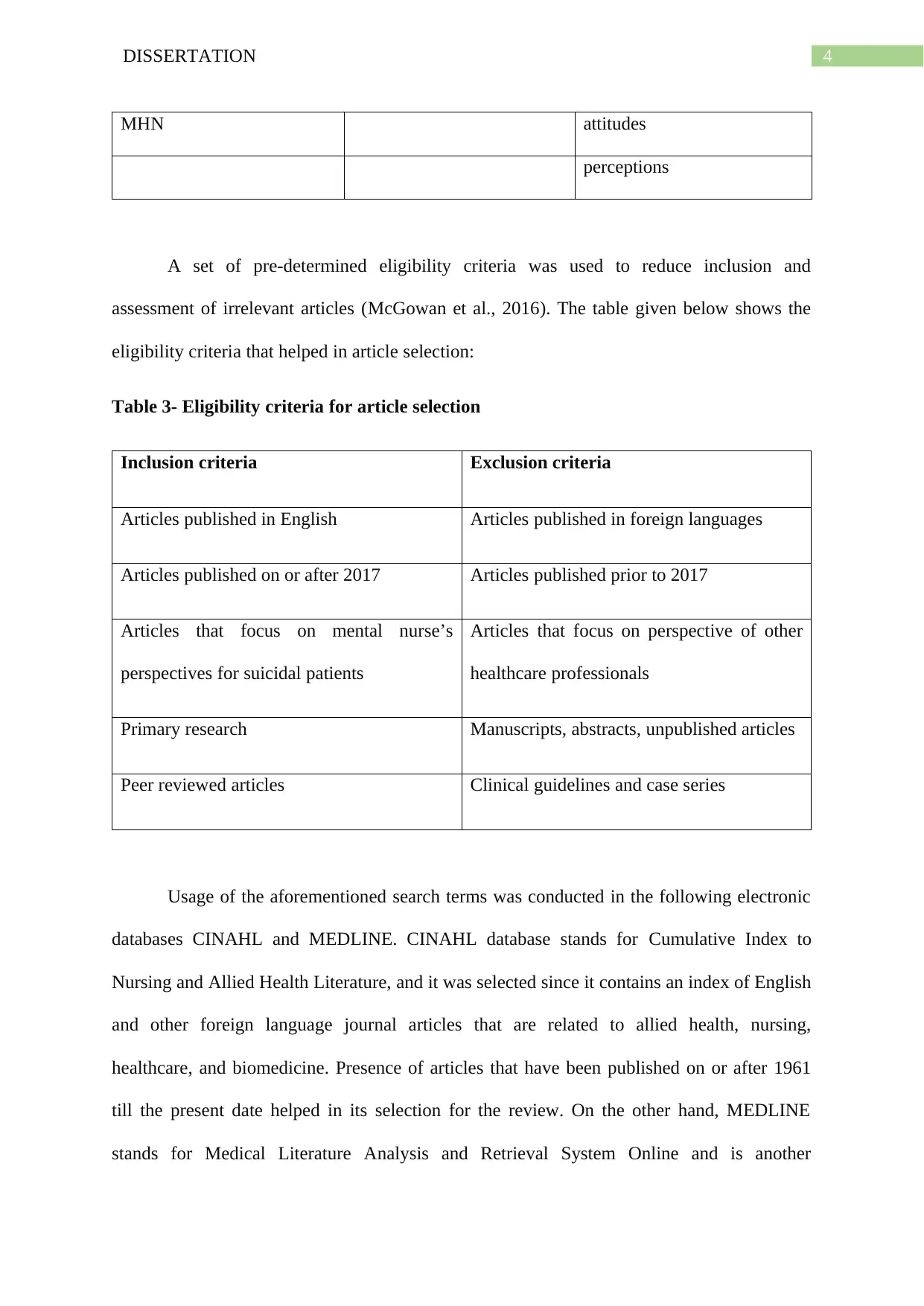
4DISSERTATION
MHN attitudes
perceptions
A set of pre-determined eligibility criteria was used to reduce inclusion and
assessment of irrelevant articles (McGowan et al., 2016). The table given below shows the
eligibility criteria that helped in article selection:
Table 3- Eligibility criteria for article selection
Inclusion criteria Exclusion criteria
Articles published in English Articles published in foreign languages
Articles published on or after 2017 Articles published prior to 2017
Articles that focus on mental nurse’s
perspectives for suicidal patients
Articles that focus on perspective of other
healthcare professionals
Primary research Manuscripts, abstracts, unpublished articles
Peer reviewed articles Clinical guidelines and case series
Usage of the aforementioned search terms was conducted in the following electronic
databases CINAHL and MEDLINE. CINAHL database stands for Cumulative Index to
Nursing and Allied Health Literature, and it was selected since it contains an index of English
and other foreign language journal articles that are related to allied health, nursing,
healthcare, and biomedicine. Presence of articles that have been published on or after 1961
till the present date helped in its selection for the review. On the other hand, MEDLINE
stands for Medical Literature Analysis and Retrieval System Online and is another
MHN attitudes
perceptions
A set of pre-determined eligibility criteria was used to reduce inclusion and
assessment of irrelevant articles (McGowan et al., 2016). The table given below shows the
eligibility criteria that helped in article selection:
Table 3- Eligibility criteria for article selection
Inclusion criteria Exclusion criteria
Articles published in English Articles published in foreign languages
Articles published on or after 2017 Articles published prior to 2017
Articles that focus on mental nurse’s
perspectives for suicidal patients
Articles that focus on perspective of other
healthcare professionals
Primary research Manuscripts, abstracts, unpublished articles
Peer reviewed articles Clinical guidelines and case series
Usage of the aforementioned search terms was conducted in the following electronic
databases CINAHL and MEDLINE. CINAHL database stands for Cumulative Index to
Nursing and Allied Health Literature, and it was selected since it contains an index of English
and other foreign language journal articles that are related to allied health, nursing,
healthcare, and biomedicine. Presence of articles that have been published on or after 1961
till the present date helped in its selection for the review. On the other hand, MEDLINE
stands for Medical Literature Analysis and Retrieval System Online and is another
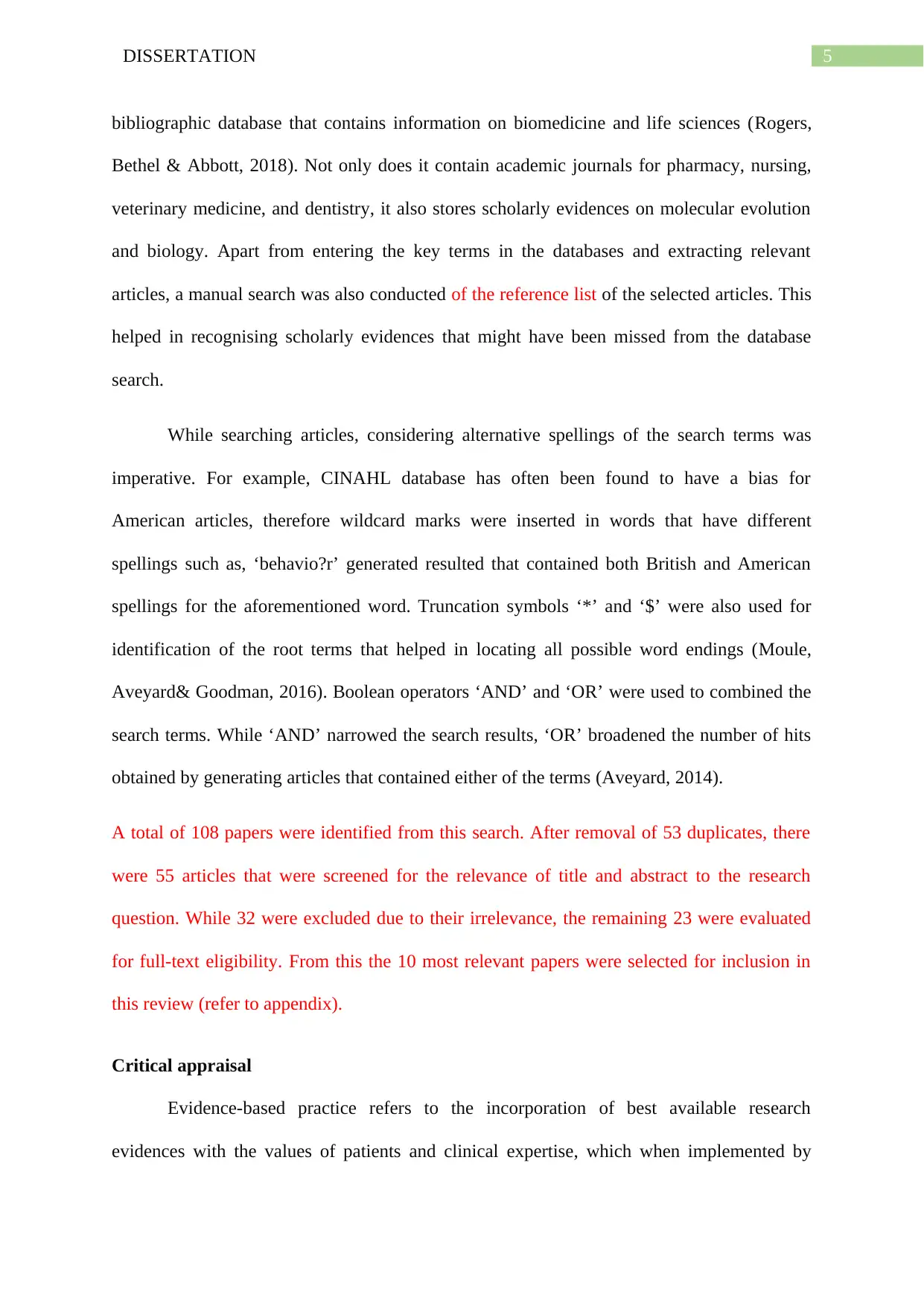
5DISSERTATION
bibliographic database that contains information on biomedicine and life sciences (Rogers,
Bethel & Abbott, 2018). Not only does it contain academic journals for pharmacy, nursing,
veterinary medicine, and dentistry, it also stores scholarly evidences on molecular evolution
and biology. Apart from entering the key terms in the databases and extracting relevant
articles, a manual search was also conducted of the reference list of the selected articles. This
helped in recognising scholarly evidences that might have been missed from the database
search.
While searching articles, considering alternative spellings of the search terms was
imperative. For example, CINAHL database has often been found to have a bias for
American articles, therefore wildcard marks were inserted in words that have different
spellings such as, ‘behavio?r’ generated resulted that contained both British and American
spellings for the aforementioned word. Truncation symbols ‘*’ and ‘$’ were also used for
identification of the root terms that helped in locating all possible word endings (Moule,
Aveyard& Goodman, 2016). Boolean operators ‘AND’ and ‘OR’ were used to combined the
search terms. While ‘AND’ narrowed the search results, ‘OR’ broadened the number of hits
obtained by generating articles that contained either of the terms (Aveyard, 2014).
A total of 108 papers were identified from this search. After removal of 53 duplicates, there
were 55 articles that were screened for the relevance of title and abstract to the research
question. While 32 were excluded due to their irrelevance, the remaining 23 were evaluated
for full-text eligibility. From this the 10 most relevant papers were selected for inclusion in
this review (refer to appendix).
Critical appraisal
Evidence-based practice refers to the incorporation of best available research
evidences with the values of patients and clinical expertise, which when implemented by
bibliographic database that contains information on biomedicine and life sciences (Rogers,
Bethel & Abbott, 2018). Not only does it contain academic journals for pharmacy, nursing,
veterinary medicine, and dentistry, it also stores scholarly evidences on molecular evolution
and biology. Apart from entering the key terms in the databases and extracting relevant
articles, a manual search was also conducted of the reference list of the selected articles. This
helped in recognising scholarly evidences that might have been missed from the database
search.
While searching articles, considering alternative spellings of the search terms was
imperative. For example, CINAHL database has often been found to have a bias for
American articles, therefore wildcard marks were inserted in words that have different
spellings such as, ‘behavio?r’ generated resulted that contained both British and American
spellings for the aforementioned word. Truncation symbols ‘*’ and ‘$’ were also used for
identification of the root terms that helped in locating all possible word endings (Moule,
Aveyard& Goodman, 2016). Boolean operators ‘AND’ and ‘OR’ were used to combined the
search terms. While ‘AND’ narrowed the search results, ‘OR’ broadened the number of hits
obtained by generating articles that contained either of the terms (Aveyard, 2014).
A total of 108 papers were identified from this search. After removal of 53 duplicates, there
were 55 articles that were screened for the relevance of title and abstract to the research
question. While 32 were excluded due to their irrelevance, the remaining 23 were evaluated
for full-text eligibility. From this the 10 most relevant papers were selected for inclusion in
this review (refer to appendix).
Critical appraisal
Evidence-based practice refers to the incorporation of best available research
evidences with the values of patients and clinical expertise, which when implemented by
⊘ This is a preview!⊘
Do you want full access?
Subscribe today to unlock all pages.

Trusted by 1+ million students worldwide
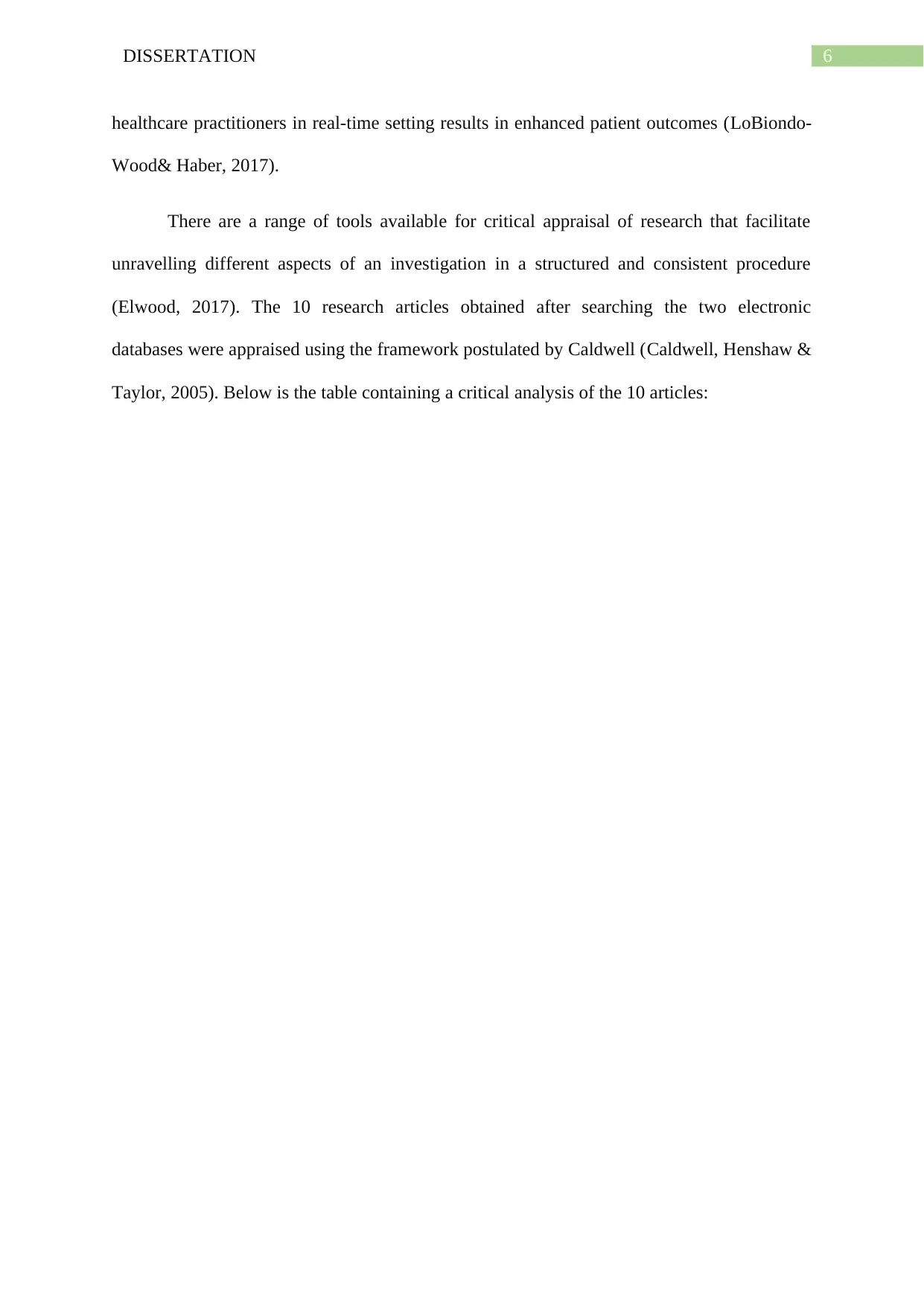
6DISSERTATION
healthcare practitioners in real-time setting results in enhanced patient outcomes (LoBiondo-
Wood& Haber, 2017).
There are a range of tools available for critical appraisal of research that facilitate
unravelling different aspects of an investigation in a structured and consistent procedure
(Elwood, 2017). The 10 research articles obtained after searching the two electronic
databases were appraised using the framework postulated by Caldwell (Caldwell, Henshaw &
Taylor, 2005). Below is the table containing a critical analysis of the 10 articles:
healthcare practitioners in real-time setting results in enhanced patient outcomes (LoBiondo-
Wood& Haber, 2017).
There are a range of tools available for critical appraisal of research that facilitate
unravelling different aspects of an investigation in a structured and consistent procedure
(Elwood, 2017). The 10 research articles obtained after searching the two electronic
databases were appraised using the framework postulated by Caldwell (Caldwell, Henshaw &
Taylor, 2005). Below is the table containing a critical analysis of the 10 articles:
Paraphrase This Document
Need a fresh take? Get an instant paraphrase of this document with our AI Paraphraser
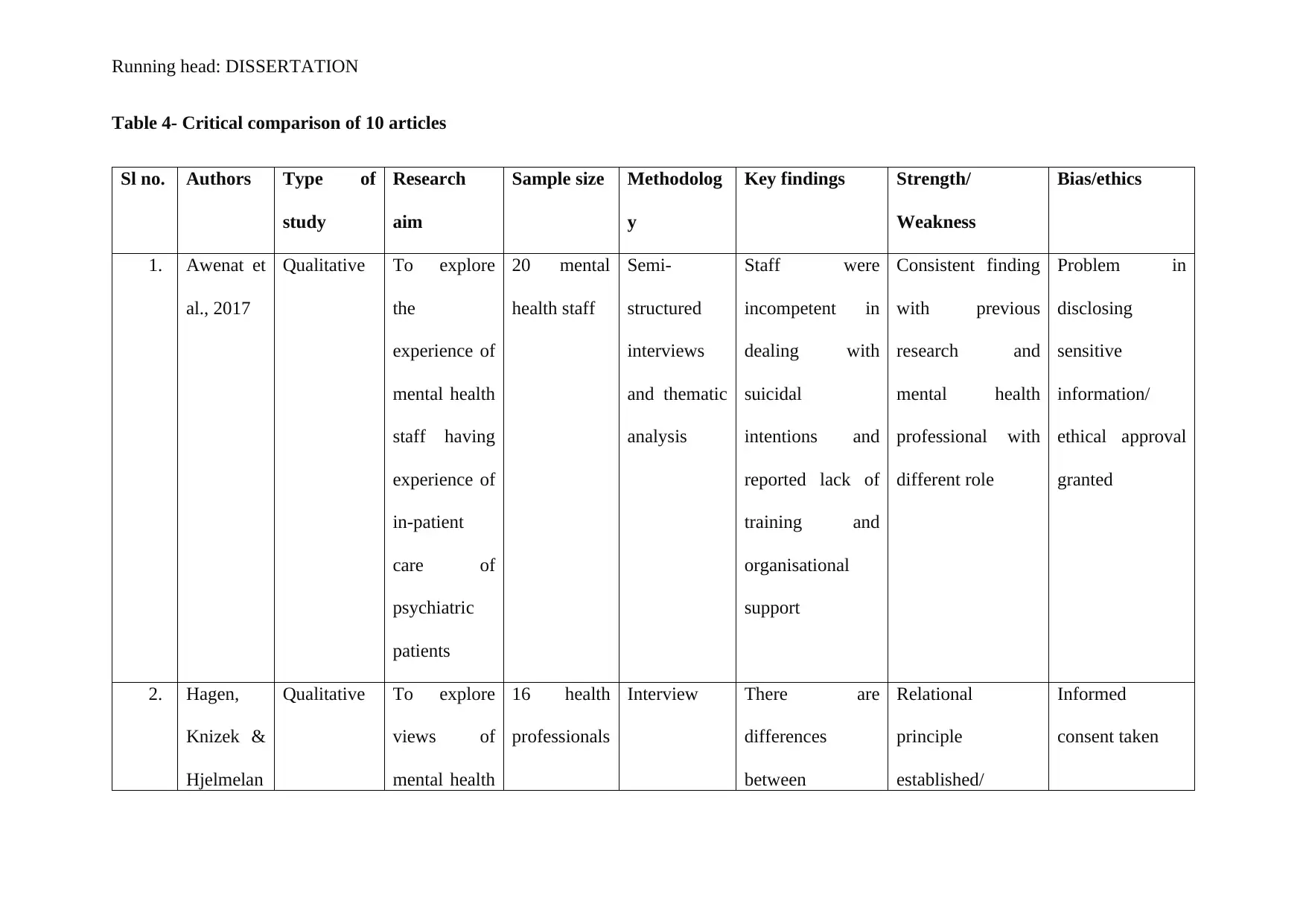
Running head: DISSERTATION
Table 4- Critical comparison of 10 articles
Sl no. Authors Type of
study
Research
aim
Sample size Methodolog
y
Key findings Strength/
Weakness
Bias/ethics
1. Awenat et
al., 2017
Qualitative To explore
the
experience of
mental health
staff having
experience of
in-patient
care of
psychiatric
patients
20 mental
health staff
Semi-
structured
interviews
and thematic
analysis
Staff were
incompetent in
dealing with
suicidal
intentions and
reported lack of
training and
organisational
support
Consistent finding
with previous
research and
mental health
professional with
different role
Problem in
disclosing
sensitive
information/
ethical approval
granted
2. Hagen,
Knizek &
Hjelmelan
Qualitative To explore
views of
mental health
16 health
professionals
Interview There are
differences
between
Relational
principle
established/
Informed
consent taken
Table 4- Critical comparison of 10 articles
Sl no. Authors Type of
study
Research
aim
Sample size Methodolog
y
Key findings Strength/
Weakness
Bias/ethics
1. Awenat et
al., 2017
Qualitative To explore
the
experience of
mental health
staff having
experience of
in-patient
care of
psychiatric
patients
20 mental
health staff
Semi-
structured
interviews
and thematic
analysis
Staff were
incompetent in
dealing with
suicidal
intentions and
reported lack of
training and
organisational
support
Consistent finding
with previous
research and
mental health
professional with
different role
Problem in
disclosing
sensitive
information/
ethical approval
granted
2. Hagen,
Knizek &
Hjelmelan
Qualitative To explore
views of
mental health
16 health
professionals
Interview There are
differences
between
Relational
principle
established/
Informed
consent taken
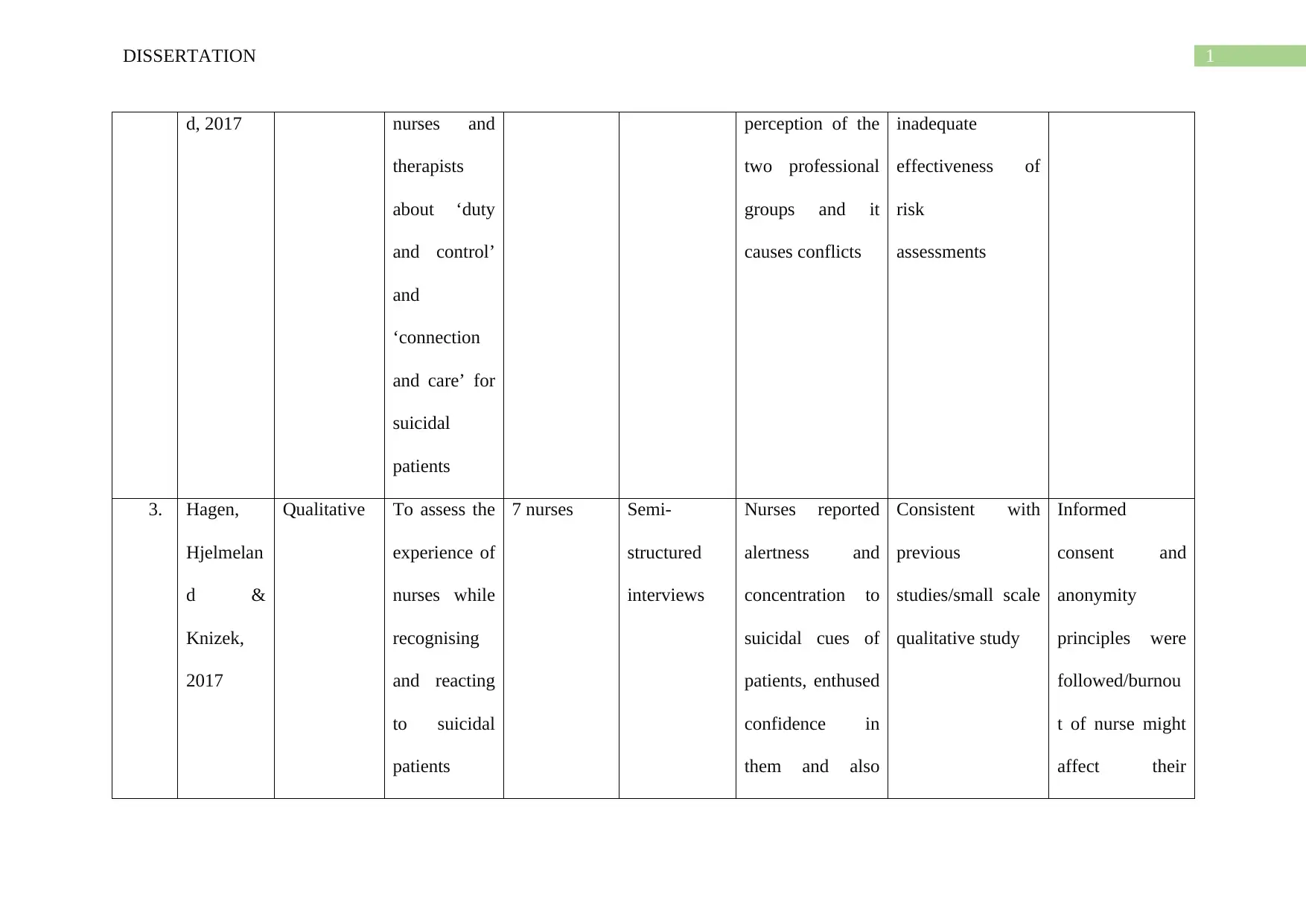
1DISSERTATION
d, 2017 nurses and
therapists
about ‘duty
and control’
and
‘connection
and care’ for
suicidal
patients
perception of the
two professional
groups and it
causes conflicts
inadequate
effectiveness of
risk
assessments
3. Hagen,
Hjelmelan
d &
Knizek,
2017
Qualitative To assess the
experience of
nurses while
recognising
and reacting
to suicidal
patients
7 nurses Semi-
structured
interviews
Nurses reported
alertness and
concentration to
suicidal cues of
patients, enthused
confidence in
them and also
Consistent with
previous
studies/small scale
qualitative study
Informed
consent and
anonymity
principles were
followed/burnou
t of nurse might
affect their
d, 2017 nurses and
therapists
about ‘duty
and control’
and
‘connection
and care’ for
suicidal
patients
perception of the
two professional
groups and it
causes conflicts
inadequate
effectiveness of
risk
assessments
3. Hagen,
Hjelmelan
d &
Knizek,
2017
Qualitative To assess the
experience of
nurses while
recognising
and reacting
to suicidal
patients
7 nurses Semi-
structured
interviews
Nurses reported
alertness and
concentration to
suicidal cues of
patients, enthused
confidence in
them and also
Consistent with
previous
studies/small scale
qualitative study
Informed
consent and
anonymity
principles were
followed/burnou
t of nurse might
affect their
⊘ This is a preview!⊘
Do you want full access?
Subscribe today to unlock all pages.

Trusted by 1+ million students worldwide
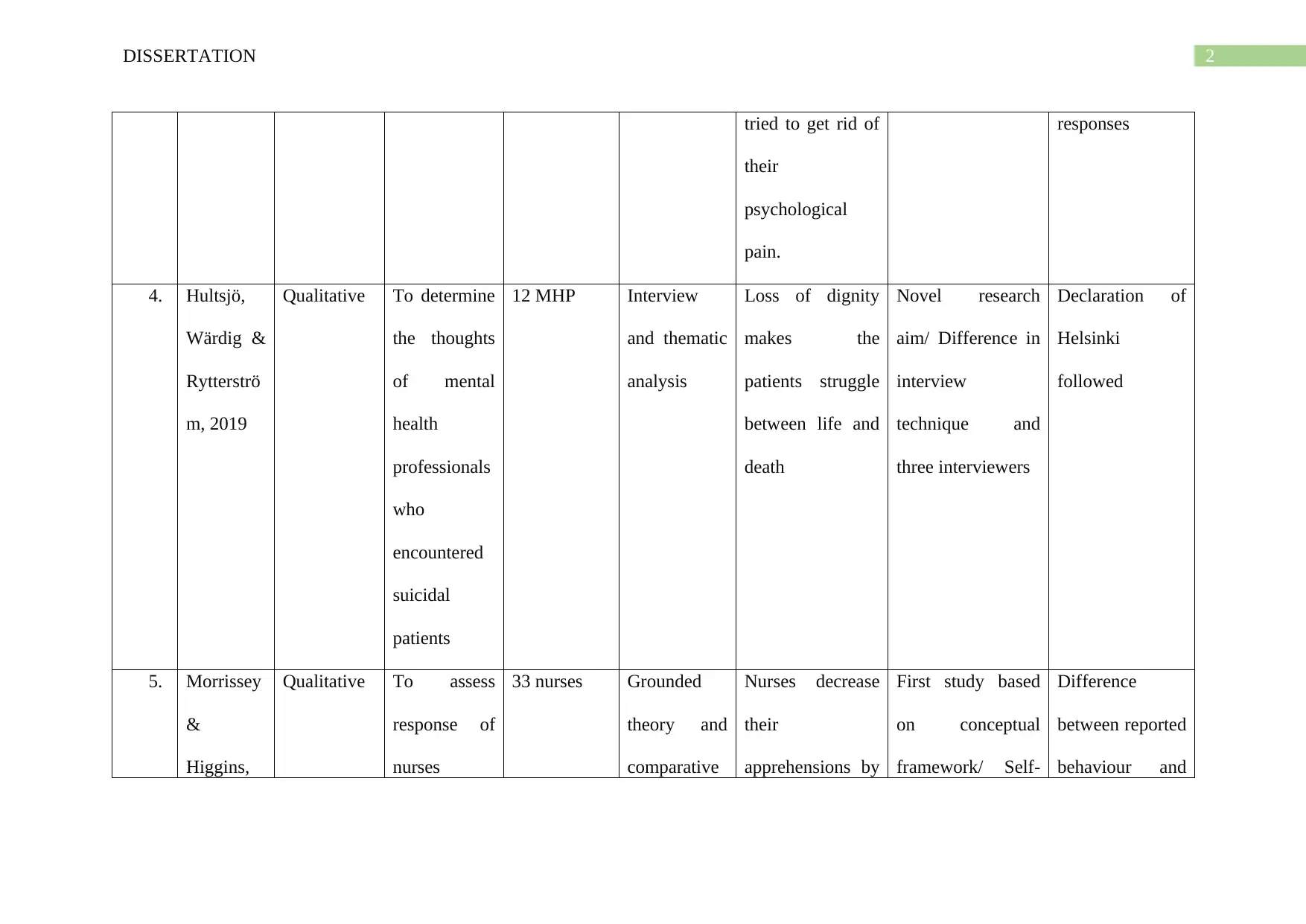
2DISSERTATION
tried to get rid of
their
psychological
pain.
responses
4. Hultsjö,
Wärdig &
Rytterströ
m, 2019
Qualitative To determine
the thoughts
of mental
health
professionals
who
encountered
suicidal
patients
12 MHP Interview
and thematic
analysis
Loss of dignity
makes the
patients struggle
between life and
death
Novel research
aim/ Difference in
interview
technique and
three interviewers
Declaration of
Helsinki
followed
5. Morrissey
&
Higgins,
Qualitative To assess
response of
nurses
33 nurses Grounded
theory and
comparative
Nurses decrease
their
apprehensions by
First study based
on conceptual
framework/ Self-
Difference
between reported
behaviour and
tried to get rid of
their
psychological
pain.
responses
4. Hultsjö,
Wärdig &
Rytterströ
m, 2019
Qualitative To determine
the thoughts
of mental
health
professionals
who
encountered
suicidal
patients
12 MHP Interview
and thematic
analysis
Loss of dignity
makes the
patients struggle
between life and
death
Novel research
aim/ Difference in
interview
technique and
three interviewers
Declaration of
Helsinki
followed
5. Morrissey
&
Higgins,
Qualitative To assess
response of
nurses
33 nurses Grounded
theory and
comparative
Nurses decrease
their
apprehensions by
First study based
on conceptual
framework/ Self-
Difference
between reported
behaviour and
Paraphrase This Document
Need a fresh take? Get an instant paraphrase of this document with our AI Paraphraser
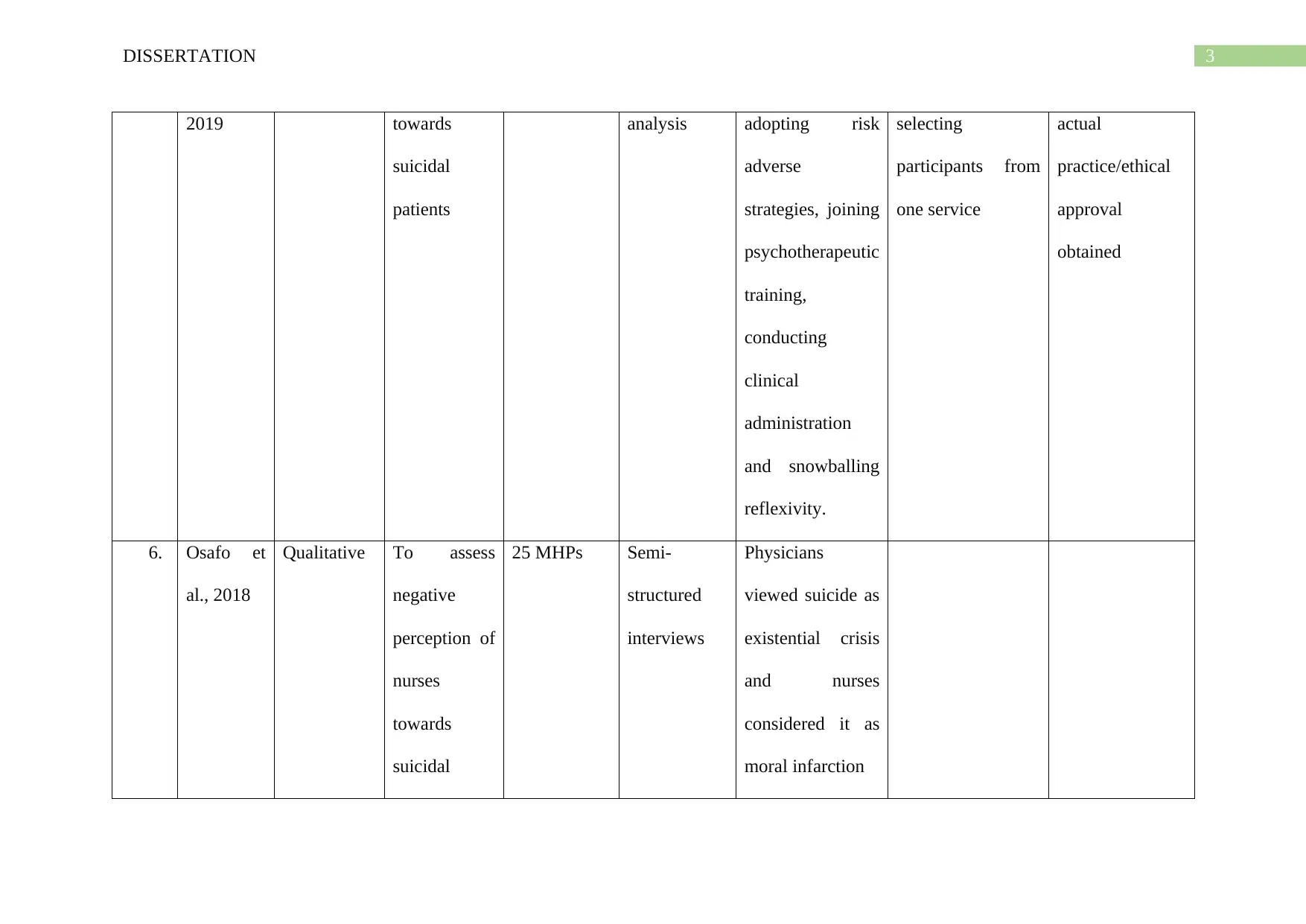
3DISSERTATION
2019 towards
suicidal
patients
analysis adopting risk
adverse
strategies, joining
psychotherapeutic
training,
conducting
clinical
administration
and snowballing
reflexivity.
selecting
participants from
one service
actual
practice/ethical
approval
obtained
6. Osafo et
al., 2018
Qualitative To assess
negative
perception of
nurses
towards
suicidal
25 MHPs Semi-
structured
interviews
Physicians
viewed suicide as
existential crisis
and nurses
considered it as
moral infarction
2019 towards
suicidal
patients
analysis adopting risk
adverse
strategies, joining
psychotherapeutic
training,
conducting
clinical
administration
and snowballing
reflexivity.
selecting
participants from
one service
actual
practice/ethical
approval
obtained
6. Osafo et
al., 2018
Qualitative To assess
negative
perception of
nurses
towards
suicidal
25 MHPs Semi-
structured
interviews
Physicians
viewed suicide as
existential crisis
and nurses
considered it as
moral infarction
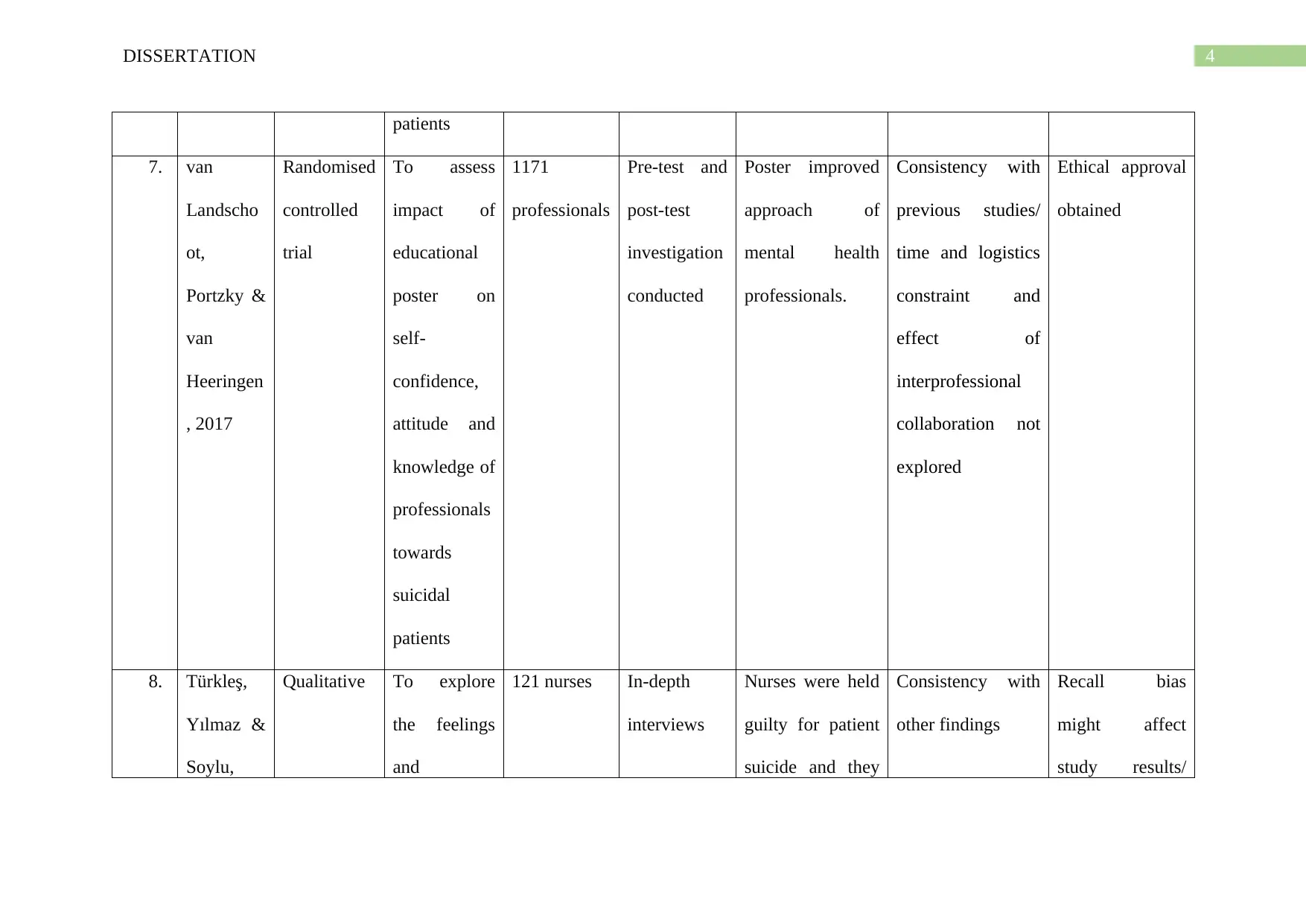
4DISSERTATION
patients
7. van
Landscho
ot,
Portzky &
van
Heeringen
, 2017
Randomised
controlled
trial
To assess
impact of
educational
poster on
self-
confidence,
attitude and
knowledge of
professionals
towards
suicidal
patients
1171
professionals
Pre-test and
post-test
investigation
conducted
Poster improved
approach of
mental health
professionals.
Consistency with
previous studies/
time and logistics
constraint and
effect of
interprofessional
collaboration not
explored
Ethical approval
obtained
8. Türkleş,
Yılmaz &
Soylu,
Qualitative To explore
the feelings
and
121 nurses In-depth
interviews
Nurses were held
guilty for patient
suicide and they
Consistency with
other findings
Recall bias
might affect
study results/
patients
7. van
Landscho
ot,
Portzky &
van
Heeringen
, 2017
Randomised
controlled
trial
To assess
impact of
educational
poster on
self-
confidence,
attitude and
knowledge of
professionals
towards
suicidal
patients
1171
professionals
Pre-test and
post-test
investigation
conducted
Poster improved
approach of
mental health
professionals.
Consistency with
previous studies/
time and logistics
constraint and
effect of
interprofessional
collaboration not
explored
Ethical approval
obtained
8. Türkleş,
Yılmaz &
Soylu,
Qualitative To explore
the feelings
and
121 nurses In-depth
interviews
Nurses were held
guilty for patient
suicide and they
Consistency with
other findings
Recall bias
might affect
study results/
⊘ This is a preview!⊘
Do you want full access?
Subscribe today to unlock all pages.

Trusted by 1+ million students worldwide
1 out of 45
Related Documents
Your All-in-One AI-Powered Toolkit for Academic Success.
+13062052269
info@desklib.com
Available 24*7 on WhatsApp / Email
![[object Object]](/_next/static/media/star-bottom.7253800d.svg)
Unlock your academic potential
Copyright © 2020–2025 A2Z Services. All Rights Reserved. Developed and managed by ZUCOL.





